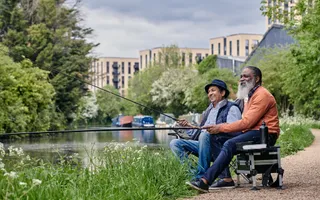Eels are born in the Sargasso Sea, within the Atlantic Ocean. After about three years swimming the Gulf Stream, they reach the UK and Europe as tiny transparent elvers known as glass eels. Here they gradually mature, becoming a darker green/brown in colour with a silvery belly. They inhabit most waterbodies and may even crawl over flooded land to access pools unconnected by streams or ditches.
They prefer dark and heavily coloured waters, or waters with plenty of silt and mud at the bottom. They mainly feed at night and generally scavenge for food, preying on dead and dying animals, fish and invertebrates. At between 8 to 18 years the mature eels then head back across the Atlantic to the Sargasso Sea to spawn.
Status:
- Listed as Critically Endangered on the International Union for Conservation of Nature (IUCN) Red List of Threatened Species
- UK Biodiversity Action Plan Priority Species
- On the OSPAR list of threatened and/or declining species and habitats
- Species of principle importance for the purpose of conserving of biodiversity under the Natural Environment and Rural Communities Act 2006
- Protected under the European Eel Regulation (European Commission) No 1100/2007 and the Eels (England and Wales) Regulations 2009
Appearance: eels have a distinctive elongated, cylindrical body shape with small gill openings, one pair of pectoral fins and no pelvic fins.
British record: 11lb 3oz (British record committee 2024)
Lifespan: eight to possibly 100 years (if landlocked)
How to catch an eel
Early evening or during the night is the best time to target and catch eels. The best baits are generally small sections of dead-bait, pieces of lobworms or maggots. With eel welfare in mind be sure to use a safe eel rig, lip hooking methods such as ‘the twig' or ‘Semi-fixed' method fished in conjunction with a short trace and sensitive bite detection will help prevent the eel swallowing the hook which could prove fatal.
Best locations are deep margins, around weed beds or sunken branches and fishing your hook bait over a bed of dead maggots can be very effective. Match hook size to bait size with typical hooks used in the size 6 to 10 bracket.
In the past, it was common practice to take eels for the pot when their numbers were high. However, removal of eels for any purpose is no longer permitted due to their endangered species status. So, all eels caught on rod and line must be returned to the waterway, either immediately or in a competition after the weigh in has taken place.
Where to catch an eel
Eels can be potentially found in all waterbodies. The Gloucester & Sharpness Canal produces many small eels to anglers. Large eels up to 9lb have been caught in lock chambers during lock repair works on our canals.






